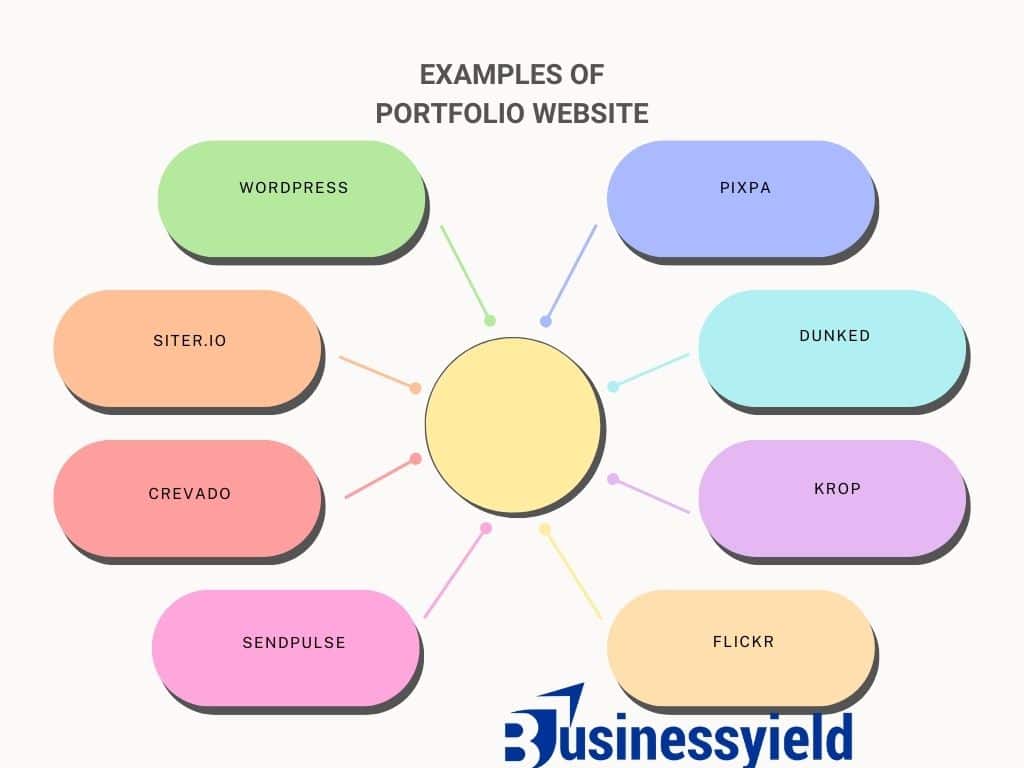I solely believe that a portfolio website is crucial for displaying my best work and enhancing my online presence, ultimately opening up new opportunities for jobs and collaborations. In other words, creating a portfolio website that truly stands out can pose quite a challenge.
So, it’s always helpful to review some of the top portfolio website examples for inspiration when crafting your own. To assist you in reaching your goal, I have put together a collection of more than five portfolio website examples, some of which I’ve used myself. They are also designed for different roles, like writers, students, and notable individuals.
These examples showcase the distinctive features that make them stand out. Keep an eye out for this article as I walk you through all you need to know.
What Is a Portfolio Website?
A portfolio website showcases your work, achievements, skills, and experiences. Having a portfolio website is a great way to showcase my personality, thoughts, and skills to my target audience. Thus, sharing information about your services can assist potential clients in understanding what you offer and how to engage with your services.
Also, I’ve noticed that portfolio websites are quite popular among job seekers in creative fields. Typically, these websites are not designed for selling pre-made prints or products. Instead, the goal is to inspire visitors to reach out to the creator and collaborate over the long term.
KeyPoints
- A portfolio website is a great way to showcase your work, achievements, skills, and background.
- The core objective of a portfolio website is to motivate visitors to contact the creator and work together for an extended time.
- A well-designed portfolio website must be meticulously designed to meet the needs and goals of the market.
- A good portfolio website can be a valuable asset for individuals at any point in their professional journey.
Who Are Portfolio Websites For?
In my opinion, having a well-designed portfolio website can greatly benefit people at all stages of their careers. How about I make a list of some of them?
Read on as I dive right in!
#1. Artists Who Work With Visual Mediums
Artists like photographers, illustrators, comics creators, makeup artists, and other creatives find it essential to have portfolio websites to showcase their work.
#2. People Who Work on Websites and Design
IT professionals can also use their portfolio websites to display websites and web applications they have developed.
#3. Content Creators and Writers
Creators like authors, bloggers, journalists, and storytellers can easily showcase their top published works on their portfolio websites.
#4. Artisans
Artisans like potters, costume designers, shoemakers, and others can attract more commissions by showcasing their creations on a personalized portfolio website.
#5. Graduates
Young professionals might consider setting up portfolio websites to showcase their academic achievements, projects, internships, and skills as a way to differentiate themselves in the job market.
#6. People Who Design Buildings and Interiors
These professionals have the option to showcase their projects and skills on specialized portfolio websites.
#7. Teachers and Coaches
Portfolio websites are also a great tool for online educators to highlight their students’ achievements.
I hope I’ve managed to persuade you that having a portfolio website is a fantastic idea if you’re involved in any career path that can be showcased and described. Now, let’s get into some of the examples.
Read also: PORTFOLIO MANAGEMENT SOFTWARE: Top Investment Software In 2023
Examples of Portfolio Website

Here are some portfolio website examples I’ve selected to help you create your own. Every single one of these portfolio websites is created with the unique requirements and objectives of each designer in mind. I found these portfolio website examples to be exceptional because of their design, the way they present client work, and their distinct personalities. Read along as I highlight what sets each of them apart.
#1. WordPress
This portfolio website is ideal for bloggers and writers. WordPress is a powerful content management platform that enables me to easily create a blog with a portfolio page. WordPress offers over 100 free themes to help you create a unique blog and showcase your work, even though it’s not tailored for freelance writers. In essence, if you want full creative control over your portfolio, this option is perfect for you.
Also, if you want to showcase your writing and other skills, WordPress could be a good choice for you. Let’s say you’re looking to set up a page to display your writing or photography. WordPress offers a variety of themes that allow you to showcase your creative work with flexibility.
#2. Siter.io
Siter.io intuitive interface allows you to design directly in the browser, autonomously, using familiar tools. Starting from scratch or utilizing one of their templates, Siter.io enables you to craft portfolios that match your distinct vision.
Siter.io collaborates with Figma and offers a well-liked plugin that can quickly turn your designs into fully functional websites. This platform offers great flexibility, enabling you to create a portfolio tailored to your preferences without any design restrictions. Furthermore, Siter.io provides secure hosting and SSL certification to keep your website safe and protected at all times.
#3. Crevado
Crevado is a user-friendly platform for creating a portfolio. You can easily upload your work and arrange it on the screen with a simple drag-and-drop tool. Your portfolio will look great on any device—smartphone or desktop—thanks to automatic optimization.
Crevado also offers secure hosting and SSL certification to ensure your portfolio site stays safe. You have the flexibility to tailor your design to your liking without the need to write any code. You also have the option to sell your work online through the platform’s connections with PayPal and Fotomoto. One small drawback is that users who opt for the free plan are unable to remove the Crevado link from their website footer. To access that feature, you’ll need to switch to a pro account.
#4. SendPulse
SendPulse offers a variety of tools for email marketing, notification creation, and SMS marketing. You can concentrate on the enjoyable aspects of selling products or services online while minimizing recurrent and manual tasks.
This portfolio website example simplifies the process of creating portfolio websites, which is just one aspect of the overall picture. SendPulse allows you to easily create polished portfolio websites quickly, even if you’re new to it. Their portfolio website builder is based on templates, yet it offers plenty of creative freedom and customization choices.
#5. Pixpa
Pixpa is a comprehensive, user-friendly portfolio website platform created to support creative professionals and business owners in constructing professional portfolios. It also provides a variety of contemporary templates that are mobile-friendly and responsive. These templates can be easily made using the visual editor and drag-and-drop page builder.
In addition, Pixpa offers a wide range of features, such as blogging tools, and built-in SEO and marketing tools, making it an ideal platform for writers and creative professionals to build their portfolios.
You may want to see: PORTFOLIO LOAN: What It Is, How It Works, and Who Qualifies
#6. Dunked
Dunked is a portfolio website designed specifically for designers and creatives. This portfolio website allows you to showcase your talents to over 100,000 users on a sleek and straightforward platform. Dunked offers a variety of professionally designed templates that are created to enhance your creativity and showcase your work. All you have to do is select the best option for your aesthetic and toggle between themes as needed.
Furthermore, you can feel free to upload images from popular sites such as YouTube, Flickr, and SoundCloud. You can easily drag and drop them until your website looks just the way you envision.
#7. Krop
Krop is a portfolio website where creative professionals showcase their portfolios to top industry brands worldwide. Krop’s software allows creatives to streamline their editing and formatting tasks, giving them more time to focus on their projects.
This portfolio website is also a place where professionals can connect and find job opportunities worldwide. You can also position yourself strategically in front of well-known creative brands and discover opportunities at various experience levels.
#8. Flickr
Flickr is quite popular with a vast collection of photos and a large community of photographers. It’s a great place to showcase your work, interact with fellow photographers, and get ideas for your next projects.
Yet, Flickr’s platform is community-oriented, which can sometimes make it challenging to display your top work and maintain a professional appearance, especially because the site is primarily used for sharing images with friends and family. However, many designers recommend having a refined portfolio website and linking to it from Flickr.
Business Yield Portfolio Website Checklist
What Is the Difference Between a Website and a Portfolio Website?
A portfolio website stands out from a typical website as it focuses on showcasing your photos and enticing visitors to explore as many of them as they can. Make sure the interface is user-friendly and straightforward, and consider offering a custom domain for a more polished look.
How Long Does It Take to Create a Portfolio Website?
Building a portfolio website can vary in time from just an hour to several weeks, depending on factors like the content management system chosen, your expertise, and the specific needs of your site.
How Many Projects Should I Have in My Portfolio Website?
Having a portfolio website with a well-curated selection of projects is essential. So, it’s important to strike the right balance when it comes to the number of projects you showcase. Aim for a range of 3-6 projects that truly represent your skills and expertise. By clearly expressing your preferred work style, you can effectively engage your audience without overwhelming them with excessive information. This ensures that your design work remains memorable and impactful.
In Conclusion
There are many different places where you can include your portfolio, like your PDF portfolio, emails, cover letters, CVs, and social media profiles. Just keep in mind that your portfolio website is always a work in progress, just like your career journey. Make sure to update it regularly so it always reflects you, your work, skills, and interests accurately. As you switch out old projects for new ones, make small design tweaks, or think about a visual overhaul, remember that as your career progresses, your portfolio website can and should evolve.
References
- blog.hubspot.com
- creativelivesinprogress.com
- sendpulse.com
- TOP 23 PROFESSIONAL SKILLS TO PUT ON YOUR RESUME
- Photography Business Cards: Free Templates, Samples, Ideas, Tools (+ Quick Guide)
- PORTFOLIO MANAGEMENT SOFTWARE: Top Investment Software In 2023
- PROJECT PORTFOLIO MANAGEMENT: Meaning, Top Software, Processes & Benefits
- PORTFOLIO LOAN: What It Is, How It Works, and Who Qualifies






